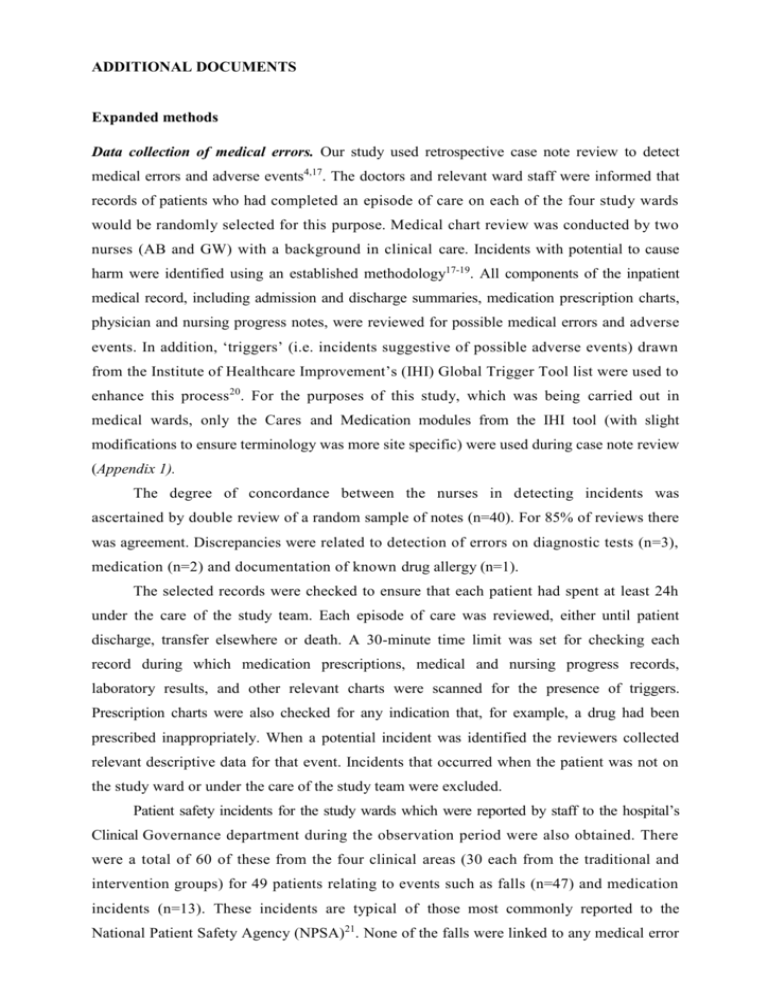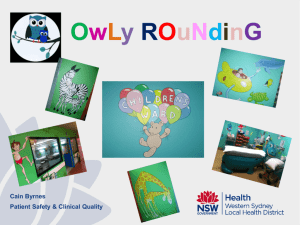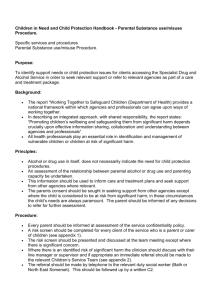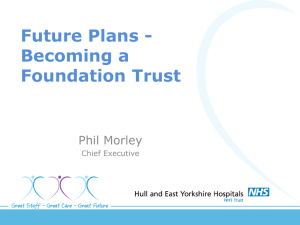additional documents
advertisement

ADDITIONAL DOCUMENTS Expanded methods Data collection of medical errors. Our study used retrospective case note review to detect medical errors and adverse events4,17. The doctors and relevant ward staff were informed that records of patients who had completed an episode of care on each of the four study wards would be randomly selected for this purpose. Medical chart review was conducted by two nurses (AB and GW) with a background in clinical care. Incidents with potential to cause harm were identified using an established methodology17-19. All components of the inpatient medical record, including admission and discharge summaries, medication prescription charts, physician and nursing progress notes, were reviewed for possible medical errors and adverse events. In addition, ‘triggers’ (i.e. incidents suggestive of possible adverse events) drawn from the Institute of Healthcare Improvement’s (IHI) Global Trigger Tool list were used to enhance this process20. For the purposes of this study, which was being carried out in medical wards, only the Cares and Medication modules from the IHI tool (with slight modifications to ensure terminology was more site specific) were used during case note review (Appendix 1). The degree of concordance between the nurses in detecting incidents was ascertained by double review of a random sample of notes (n=40). For 85% of reviews there was agreement. Discrepancies were related to detection of errors on diagnostic tests (n=3), medication (n=2) and documentation of known drug allergy (n=1). The selected records were checked to ensure that each patient had spent at least 24h under the care of the study team. Each episode of care was reviewed, either until patient discharge, transfer elsewhere or death. A 30-minute time limit was set for checking each record during which medication prescriptions, medical and nursing progress records, laboratory results, and other relevant charts were scanned for the presence of triggers. Prescription charts were also checked for any indication that, for example, a drug had been prescribed inappropriately. When a potential incident was identified the reviewers collected relevant descriptive data for that event. Incidents that occurred when the patient was not on the study ward or under the care of the study team were excluded. Patient safety incidents for the study wards which were reported by staff to the hospital’s Clinical Governance department during the observation period were also obtained. There were a total of 60 of these from the four clinical areas (30 each from the traditional and intervention groups) for 49 patients relating to events such as falls (n=47) and medication incidents (n=13). These incidents are typical of those most commonly reported to the National Patient Safety Agency (NPSA)21. None of the falls were linked to any medical error while 6 medication incidents were detected by the researchers in the selected notes and associated with a medical error. Incident classification. An adverse event was defined as an incident in which medical management resulted in harm to the patient. In addition, any errors with potential to cause harm were documented, reviewed and categorised (Appendix 2). The rationale for this approach is based on the understanding that ‘near-misses’, represented by ‘failures in process of care’20, afford ‘free lessons’ in the promotion of patient safety by highlighting error-prone areas of healthcare delivery22. Incident certification. Before beginning data collection, all staff received intensive training in the consistent, objective collection of data using standardized forms. Given that it was not possible to blind data collectors to the study schedule, determinations of the preventability and classification of events were not made by the primary data collectors. Instead, each suspected error or adverse event identified was independently rated by two senior physicians who were unaware of the identity of those involved or whether the incident occurred during the traditional or intervention rota. Blinded reviewers cate gorized each incident as an adverse event, non-intercepted potential adverse events, intercepted potential adverse events, or error with little potential for harm (Appendix 3) and rated the preventability of adverse events using a Likert scale (was prevented, definitely preventable, probably preventable, probably not preventable, or definitely not preventable); the preventability scale was dichotomized to include only “preventable events” and “nonpreventable events” before analysis. Events deemed more likely to be due to patients’ underlying illness than to medical therapy were excluded (Appendix 4). The inter-rater reliability was calculated by means of the Cohen’s kappa (κ) statistic. Any disagreements were resolved either by discussion or a third physician. Questionnaire. Doctors were asked to complete a questionnaire with background information about themselves and an SF-36 questionnaire at the beginning of the study to measure wellbeing. Data were analysed as norm-adjusted SF-36 mean scores (SD) by 1998 US population where mean=50 and SD=10. Interviews. Doctors were consented and assured of confidentiality and informed that the interview was about their experience of the shift system they had been working over the last three months. They were asked a series of open ended questions according to a semi-structured questionnaire about the shift system, patient safety, their own rest and sleep, educational opportunities and handover experiences. Interviews were recorded and transcribed and descriptive themes were extracted. Interviews were conducted in the last three weeks of the study for all but one doctor who was interviewed a week after the study period ended. The majority of interviews were conducted by the same interviewer (FT). Descriptive 2 themes were extracted by FT and then independently by the other two interviewers (GW and AB) who each reviewed half of the interviews with equal representation of doctors in each rota and then compared. For themes extracted by only one extractor, the transcript was referred to again and agreement was reached by discussion. There was agreement between the first and second extractor for 76% themes. All descriptive themes included for analysis were derived from comments made by doctors talking about their own experience of the shift system they were working. Descriptive themes were grouped into major themes according to broad category headings which corresponded to the four study objectives described above. Analysis was qualitative23. Handovers. Thirty-four handover sessions were observed during the course of the study. Conversations between the participants were recorded using a portable sound recorder and notes taken by the observer regarding the identity of the speakers, who else attended and how the handover was conducted. Expanded results Interview findings. Workload issues and Perception of Patient Safety - Reduced junior medical staff cover during the normal day was reported by all 5 doctors on CDU ward, 2 of 4 on the Endocrinology ward and 4 of 10 on the two traditional rota wards (Boxes 1 and 2 in appendix). Comments were made about potential for delay in investigation when daytime junior staff levels were low. Another theme was lack of time for interaction with the rest of the team with less chance of feed-back on their performance. On CDU there is always frequent changeover of patients. In the general medical setting the perception of doctors in the intervention group was that because of frequent shift changes more time was needed to familiarise themselves with the new patients. Learning Opportunities - Most doctors in the intervention group felt that their educational opportunities were compromised. Doctors in the traditional group generally made positive comments about learning opportunities (Box 3 in appendix). Rest and Sleep - Comments on rest and sleep varied (Box 4 in appendix). Some of the intervention group doctors welcomed the shorter shifts because they were less tired and felt they were performing their duties better as a result but others felt that they were performing worse because of the increased workload despite feeling less tired. Quality of Life (Social life) – Both intervention and traditional groups reported that working in the evening or on night shifts and at weekends had a negative impact on social and family life. Hand over – Doctors were almost unanimous in their description of procedures and selection of patients for handover. They usually compiled a list of patients and the jobs that needed to be done for each one either after clerking new patients or during a ward round. This list formed the basis of the handover. Patients would then be ‘handed over’ on a one-to-one basis, sometimes in person and sometimes over the ‘phone. Doctors reported that patients would 3 be selected for hand over according to the following criteria: (i) “Sick” or unstable patients whether or not specific tasks need doing so that the oncoming doctor is aware of the problem; (ii) Patients who have investigations or results pending. Some also reported that they would hand over or be handed over jobs that had not been done because the outgoing doctor had not had time to do them. Few had concerns about the quality of handover but several spoke about the risk of omissions in care when patients were the subject of frequent handovers on the intervention rota. Observation of handovers. Thirty-four handovers were observed. Often the extra handovers during the frequent shift changeover did not take place or happened only informally. 4 Box 1. Workload issues and perception of patient safety Intervention (Int) (CDU) Int4 “The only concern is again lack of staff ... I am supposed to leave at 5 o’clock but can’t because for patient safety issues I have to wait and still carry on working and I think that will be solved if there is proper number of staff”. “It is better, the hours, the new system but with this amount of work and hassle and feeling that you didn’t do the job, [it] is better to have 1 2h shift and enough staff.” Int5 ”I came on to the ward to see a sick patient. That delayed the starting of the ward round. If there had been another SHO on, well there used to be before we did the start of the shift system, then they could have commenced the ward rounds without me”. Int1 “... 8.30 till 5 the number of SHOs are already less so the burden increases for the day. The main thing is time. I mean if we want to implement this shift system in future it is very good but if we want to implement we need more doctors.” Int3 “I think on the days when there was just one person there the fact that investigations were requested around about 1.30 perhaps 12 did mean that on a few occasions investigations weren’t done on that day whereas if it was requested at 10 o’clock as a patient is being seen they could well have had it that day and been either discharged or had their problems addressed a lot quicker." Intervention (Endocrine) Int9 “For the normal day to day ward work there were less people around which meant that every day was hugely busy... you were lucky if there was another person to help you... there are evenings where we have had to stay longer unofficially to get things done...” Int7 “Most of the cover was poor in the sense that there were 20 patients 1 SHO and 1 junior doctor so the shifts were fine the on calls were fantastic it was working in the normal hours which was very stressful and I think that everyone was struggling to get normal work done during the normal working hours.” Traditional (Trad) (Care of the Elderly) Trad10 “From a ward cover point of view generally I think it is quite good I don’t think you are overstretched necessarily having said that some days you can be handed over large lists of jobs to do before you even go to the wards so you can have a lot to be doing.” Trad1 “The 9–5 doctor was not enough to cover the new patients and whatever was going on in my wards after my on call. Trad4 “I’d say there is a generalised lack of doctors and nurses and auxiliaries and it is that simple.” Traditional (Respiratory) Trad9 “I think it is understaffed here for ward cover. The night shift is understaffed. 5 Box 2. Continuity of Care Int9 “You can come back and be the only person in your team and have a ward full of patients that you have not seen before which means that you have to obviously spend a lot longer time with each one getting to grips to why they are here and what you need to do to manage them.” Int7 “The main difficulty that I had with the system was you are taken away from the wards, then you are put back and every time you have to see new patients and this always takes you an extra 20 minutes to half an hour to get used to the patient so it takes you 30 minutes to see a new patient and then you are not on the ward for the next 3 or 4 days.” Int6 “I did not like the fact that you were one place doing one role one day, one place doing another role the other day and so continuity was really disrupted so you did not really know your patients. If you wanted to review someone it took much longer.” Trad10 “... if there is a break in the continuity, for example you go on to nights and you don’t know what happens to say a group of interesting patients or something that is difficult diagnostically, you don’t necessary follow it through, you don’t know what happened, you don’t know how your team managed it then you do miss out for that reason.” Box 3. Learning Opportunities Int8 “You don’t work essentially as a team but you work as an individual which is not the best thing in terms of education. I practically only did 3 or 4 sets of ward rounds with the consultant which actually was not very helpful because you don’t learn a lesson until you do the ward rounds because of mistakes.” Int9 “That is probably my biggest concern with the whole thing. I would worry that if other SHOs were doing this job for the whole of their shift whether it would be applicable for medical training because the on calls have meant that I have missed a lot of the consultant ward rounds just on the ward, the way the admissions rota has worked has meant that we don’t do post take ward rounds after the medical take shift that we have done and because we have been so short staffed on the ward because of other people doing on calls it has meant that I have not been able to go to any outpatient clinics where as before on the old rota I was doing one a week. So it has drastically impacted on the job learning without a doubt.” Int5 “I dread the ward rounds and I don’t see the ward round anymore as a teaching opportunity and if someone starts to even try to teach you ... you are actually sitting there thinking to be honest can you just be quick we have got 30 patients and there is only me and I have to get the jobs done.” Trad8 “You see a lot of things when you do a long shift ... the consultants I am working with at the moment are generally approachable and I feel I can ask questions and they answer and teach and things. I have learnt a lot in this job yes.” Trad10 “You do some ward cover you do some admission, you do some nights. Your learning opportunities are varied which is a good thing...” Box 4. Rest and Sleep Int2 “I think I was more awake and more alert because I am not doing 12 hours but I was doing the job of 3 people, therefore, overall the quality declined rather than improved. Because if you are trying to do 3 times the amount of workload then it does not matter how much sleep you have had the night before you are not going to be able to do it to the same safety levels.” Trad8 “At the start of the job after I had finished my nights I just I was exhausted. I usually find it takes me about a week after doing nights to kind of get back into the swing of things again. Because of the way you do nights even if you do a weekend you don’t get day off as such you just get a rest day before you start your nights or sleep day after you finish your nights. So if you finish your nights Monday morning you then have to be at work on the Tuesday which does not give you very long to alter your sleep clock back to normal again and I find that difficult...” “...It’s mental, physical to a degree. It’s not sleepiness as such. You know if you concentrate for so long or it has been a busy day you’re tired in that way and you have not got anything extra to fall back on.” Int9 “I am not particularly good at sleeping in the day if I have had a sleep the night before, I tend to just go on through and work the night shift and sleep afterwards but then I am afraid I am just one of these annoying people who sleeps very well regardless of what shift I am doing and I was tending to get a decent 7 hours during the day for the night shift.” Trad10 “I did not have major problems with feeling tiredness I think if you try and go to sleep then that’s when your problem will start if you stay awake it is not a big problem.” Appendix 1. Trigger Tool Adapted from 20 T1 T2 Cares Module Triggers Transfer to higher level of care Cardiac/respiratory arrest, Death T3 Infection Antibiotic, fever, febrile, temperature, infection, MRSA, C.difficile, Staph., sepsis, antibiotic, blood cultures T4 Thrombus, embolus VQ scan, DVT, thrombosis, thrombus, PE, emboli, x-ray, doppler T5 In-hospital stroke Infarct, weakness, speech, paralysis, hemiplegia, hem iparesis T6 T7 T8 T9 T10 T1 1 T12 T13 Abrupt drop in Hb/haematocrit >25% Transfusion, anaemia, cross match Pleural effusion ABGs Fall hypotension, confusion, dehydration Pressure ulcers Decubitus, sore, skin ulcer Any procedural complication Abnormal MEWs MEWs >4, Critical outreach team Confusion/Fit Agitation, distressed, dehydration, fall Abnormal U&Es, LFTs E.g. raised urea, creat. > 2 times baseline T14 Blood glucose <3, >10mmols/L Sliding scale insulin, BM, hyper/hypoglycaemia, ketoacidosis, insulin, Hypostop, Glucogel T15 Hypotension Blood pressure, BP dropped, low, down, syncope, collapse, faint, dizzy T16 T17 T18 Haemorrhage Dehydration/Overload Readmission within 30 days T19 Communication "not told about patient", couldni contact", "did not answer", "failed" "not done", delay T20 Other Mistake, error, complication, accident, accidental, CAE M1 M2 Medications Module Triggers Allergy Antibiotic use allergy not noted, reactions, rash, anti-histamine C diff, diarrhoea, colitis M3 M4 M5 M6 M7 Anticoagulation Anti-hypertensives Diuretics Narcotics/analgesia Abrupt medication stop INR >6, APTT, Warfarin, heparin, bleeding, haematoma, haemorrhage, Vit. K hypotension, K <3.5 , dehydration, Narcan, OD, stop M8 Other drug event Related trigger words ITU, CCU, collapse, transfer, Critical care team Bleeding, haemorrhage, haemoptysis, haematemesis, melaena, nosebleed, epistaxis, occult blood Intravenous fluids, IVI, rehydration, diarrhoea wrong dose, interaction, contraindication, monitor side effect, sub-therapeutic dose, discontinued, OD, renal function Appendix 2: Definitions used in this study Term Definition Medical error Any failure in processes of care, with a potential for harm. Unintended physical injury resulting from, or contributed to, by medical care. Adverse event A serious medical error that is intercepted before reaching the patient. Intercepted potential adverse event Non-intercepted potential adverse A serious medical error that is not intercepted and therefore reaches the patient but causes no clinically detectable harm. event Minor error Exclusion Error with little or no potential for harm Exclusion (event not adjudged to be an error following review) Appendix 3: Examples of errors detected Adverse event: 85 yr old with history of left ventricular failure, and deep vein thrombosis, admitted with shortness of breath. At time of admission taking warfarin for DVT diagnosed 8 months previously. When drug chart rewritten 10 days post admission, neither warfarin nor any other anticoagulant prescribed. 23 days post admission patient developed swelling in calf. DVT diagnosed, re-commenced on warfarin. Intercepted potential adverse event: 80 yr old admitted with unilateral back pain, causation unclear. Prescribed co-codamol and tramadol as required for pain, but no advice about administration. Pharmacist noted that tramadol was not suitable for use with co-codamol and it was never administered. Non-intercepted potential adverse event: 69yr old admitted with sudden onset back pain and urinary frequency due to possible pyelonephritis. Allergies to penicillin and clindamycin documented in referral letter but this information was not transcribed to medical notes or medication chart. Anti-infective treatment was prescribed but luckily it was neither penicillin nor clindamycin. Minor error: 75 yr old with pyrexia, hypotension, and possible sepsis. Plasma potassium level 2.9mmol/l, prescribed intravenous potassium chloride and plan made to recheck potassium level following day. However this was not done for 3 days at which time level was 3.3mmol/l. 8 Appendix 4. Physician Reviewer Error Classification Form Adapted from4 Classification of incident (circle as appropriate) 1 2 3 Adverse event Intercepted potential adverse event (near miss error with potential for harm but was intercepted before reaching patient. Non-intercepted potential adverse event (near miss error with potential for harm that was not intercepted and fortunately did not result in apparent patient consequence. 4 Error with little or no potential for harm 5 Exclusion (event not adjudged to be an error following review) Harm category (circle as appropriate) A Circumstances or events that have capacity to cause error (exclusion) B Error that did not reach patient C Error that reached patient but did not cause harm D E F G H Error that reached patient and required monitoring or intervention to confirm that it resulted in no harm Error resulting in temporary harm to patient, required intervention Error resulting in temporary harm to patient, required initial or prolonged hospitalisation Error resulting in permanent patient harm Error resulting in intervention to sustain life e.g. resuscitation/ventilation I Error resulting in patient death J Error contributing to patient death K Error that reached patient and may have caused harm but no further information available (harm may have occurred after period of review)s Preventability (circle as appropriate) 1 Prevented 2 Definitely preventable 3 Probably preventable 4 Probably not preventable 5 Definitely not preventable 9 Medication errors Name of drug (if applicable) Type of medication error (circle as appropriate, N.B. more than one may be chosen) 1 Wrong medication 2 Wrong patient 3 Known allergy to medication(s) not indicated on chart 4 Drug-drug interaction 5 Wrong dose 6 Wrong route 7 Wrong rate 8 Wrong frequency 9 Wrong duration 10 Wrong concentration/preparation error 11 Prescribed medication not given 12 Medication not discontinued as per medical plan 13 Medication not prescribed as per medical plan 14 Other, describe:




